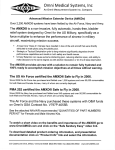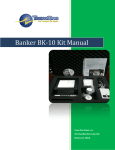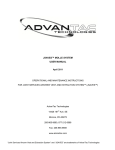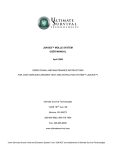Download Energy Tech Laboratories FEMP Clothes Washer User's Manual
Transcript
Federal Energy Management Program FEMP Designated Product: Clothes Washers Leading by example, saving energy and taxpayer dollars in federal facilities Legal Authorities Federal agencies are required by the Energy Policy Act of 2005 (P.L. 109-58) and Federal Acquisition Regulations (FAR) Subpart 23.2 to specify and buy ENERGY STAR®-qualified products or, in categories with no ENERGY STAR label, FEMP-designated products which are among the highest 25 percent of equivalent Purchasing Specifications for Energy-Efficient Products products for energy efficiency. Performance Requirement for Federal Purchases Washer Capacity 1.6 to 3.5 cu. ft. Modified Energy Factora 1.42 or more a) Modified Energy Factor (MEF) is the number of cubic feet of clothes washed and dried per kilowatt hour (kWh) of electricity used. MEF is calculated by dividing the tub capacity by the total energy (clothes washer, water heater and dryer) used per wash load (10 CFR 430, sub-part B, Appendix J). Buying Energy-Efficient Clothes Washers When buying residential and family-size commercial clothes washers use the Modified Energy Factor (MEF) instead of the annual energy consumption (kWh/ year) shown on the yellow EnergyGuide label. While both measures include the energy used by the washer and water heater, MEF adds that used by the dryer. Since some clothes washers are more effective at spinning moisture from clothing, resulting in less time and energy needed for drying, MEF is a more accurate indi cator of performance. Specify or select products that are ENERGY STAR-qualified (see For More Information), all of which meet the MEF shown in the Performance Requirement table. Family-sized commercial clothes washers are similar to residential clothes washers in size, performance, features, and connections. The commercial products have sturdier frames and mechanical components, a modified control panel with fewer control settings, and feature a coin box, debit card reader or other reve nue collecting device. Performance requirements apply to all forms of procurements, including: guide and project specifications; construction, renovation, repair, maintenance and energy service contracts, lease agreements and solicita tions for offers. Energy performance requirements should be included in all evaluations of solicitation responses. Model language to assist agencies with incorporating these performance requirements into their procurement documents is available at http://www.eere.energy.gov/femp/procurement/eep_modellang.cfm. The federal supply source for clothes washers is the General Services Administration (GSA), which sells them through its Multiple Awards Schedules program and on-line shopping network, GSA Advantage! Note that not all clothes washers sold by GSA are ENERGY STAR-qualified and some that do qualify may not be indicated as such. When buying clothes washers through this source, check the make and model number against the list of qualified products on the ENERGY STAR web site to assure they meet this Specification. User Tips A substantial amount of the energy used for clothes washing is for heating the water. Selecting cold water wash cycles will save energy; appropriate load-size settings will save both water and energy. ENERGY STARqualified clothes washers use less water than standard models while cleaning just as well. FEMP Designated Product: Clothes Washers In areas with limited water supplies, consider buying products with low water factors (WF), a performance For More Information: metric for comparing clothes washer water consumption independent of capacity. WF is the total water used EERE Information Center 1-877-EERE-INF or 1-877-337-3463 www.eere.energy.gov/femp/procurement/ per cycle divided by the machine’s capacity (in cu. ft.). A lower value indicates a more efficient clothes wash er. While ENERGY STAR does not currently include WF in its performance criteria, the Department of Energy (DOE) is proposing to add it in January 2007. The Consortium for Energy Efficiency (see For More Information) includes WF in its list of qualifying products. Cost-Effectiveness Example Performance Modified Energy Factor Annual Electricity Usec Annual Energy Cost Lifetime Energy Cost Water Factor (gallons/cu. ft./cycle) Annual Water Use Annual Water & Sewer Cost Lifetime Water & Sewer Cost Lifetime Utilities Costd Lifetime Utilities Cost Savings Base Modela 1.04 1,250 kWh $75 $720 11.1 14,400 gallons $58 $610 $1,330 - Required 1.42 917 kWh $55 $530 10.5 13,700 gallons $55 $580 $1,110 $220 Best Availableb 2.34 556 kWh $33 $320 3.6 4,750 gallons $19 $200 $520 $810 a) The efficiency (MEF) of the Base Model is the minimum allowed by current US DOE appliance standards. b) More efficient products may have been introduced to the market since this specification was published. Information on the best available model was obtained from the ENERGY STAR residential clothes washers products list (see For More Information). c) Includes energy for washing, drying and water heating. This value is not the same as that shown on the EnergyGuide label. d) Lifetime utilities cost is the sum of the discounted value of the annual electricity, water, and sewer costs based on aver age usage and an assumed clothes washer life of 13 years. Future energy price trends and a discount rate of 3.0% are based on federal guidelines (effective from April, 2005 to March, 2006). Future water and sewer costs are conservatively assumed to increase only at the rate of inflation. Cost-Effectiveness Assumptions In this example, annual energy use is calculated with the standard DOE test procedure for a residential clothes General Services Administration (816) 926-6760 www.fss.gsa.gov/ www.gsaadvantage.gov/ EPA/DOE ENERGY STAR has lists of qualified residential and family-size commercial clothes washers at: (888) 782-7937 www.energystar.gov/products/ American Council for and Energy Efficient Economy (ACEEE) publishes the Consumer’s Guide to Home Energy Savings which contains a chapter on laundry and list of energy-efficient clothes washers. This guide is available from ACEEE at: (202) 429-0063 www.aceee.org/ The Consortium for Energy Efficiency (CEE) provides information on utility programs promoting energy-efficient clothes washers. (617) 589-3949 www.cee1.org/ Federal Trade Commission lists the annual energy use of clothes washers and other appliance data on its web site at: www.ftc.gov/energy/ Lawrence Berkeley National Laboratory provided market research and life cycle cost analysis in support of this energyefficiency purchasing specification. (202) 646-7950 washer with a 3.3 cubic foot capacity cleaning 392 loads per year. The assumed electricity price is 6¢ per kWh, the average at federal facilities in the US. The assumed water and sewer cost is $4.00 per 1,000 gallons. Using the Cost-Effectiveness Table In the example shown above, when using electric water heating and drying, the Required clothes washer is cost-effective if its purchase price is no more than $220 above the price of the Base Model. The Best Available model is cost-effective if its price is no more than $810 above the Base Model. These savings will be less if nat ural gas is used for water heating and/or drying. What if my Utility Prices or Usage are different? ENERGY STAR has an Excel-based cost calculator for clothes washers on its web site. Go to http://www.energystar.gov/index.cfm?c=clotheswash.pr_clothes_washers, and click on Savings Calculator Clothes Washers. Select the water heater type from the pull-down menu then input the number of loads per week plus the rates for electricty, natural gas and water. The output section will automatically display results that better reflect your conditions. March 2006 A Strong Energy Portfolio for a Strong America Energy efficiency and clean, renewable energy will mean a stronger economy, cleaner environment, and greater energy independence for America. Working with a wide array of state, community, industry, and university partners, the U.S. Department of Energy’s Office of Energy Efficiency and Renewable Energy invests in a diverse portfolio of energy technologies.










